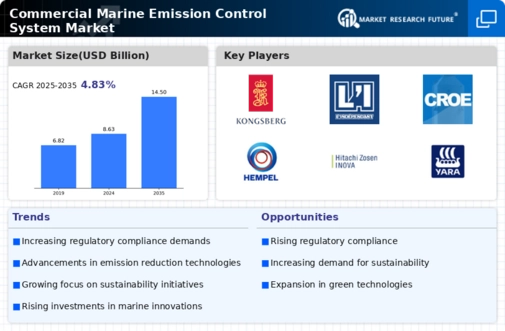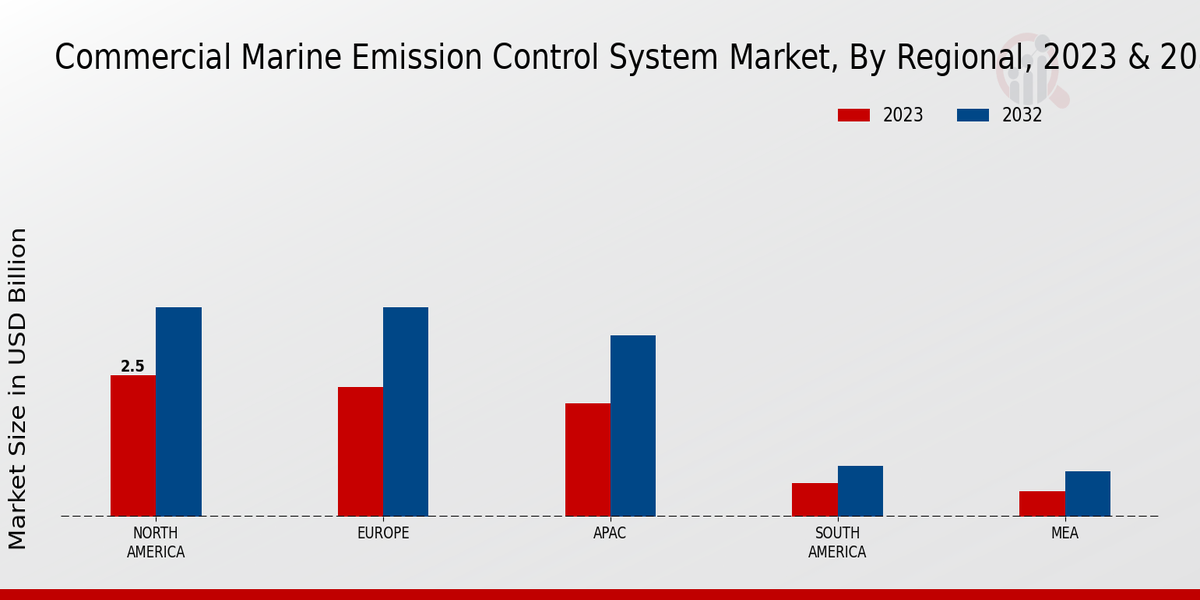Regulatory Compliance
The Global Commercial Marine Emission Control System Market Industry is significantly driven by stringent regulatory frameworks aimed at reducing emissions from marine vessels. Governments worldwide have implemented regulations such as the International Maritime Organization's MARPOL Annex VI, which sets limits on sulfur oxides and nitrogen oxides emissions. Compliance with these regulations necessitates the adoption of advanced emission control technologies, thereby propelling market growth. The increasing enforcement of these regulations is expected to contribute to the market's expansion, with projections indicating a market value of 8.63 USD Billion in 2024, underscoring the urgency for ship operators to invest in emission control systems.
Market Growth Projections
The Global Commercial Marine Emission Control System Market Industry is poised for substantial growth in the coming years. Projections indicate that the market will reach a value of 8.63 USD Billion in 2024 and is expected to grow at a CAGR of 4.83% from 2025 to 2035, ultimately reaching 14.5 USD Billion by 2035. This growth trajectory reflects the increasing adoption of emission control technologies driven by regulatory compliance, technological advancements, and heightened environmental awareness. The market's expansion is indicative of a broader shift towards sustainable practices within the maritime sector, as stakeholders recognize the importance of reducing emissions and mitigating environmental impacts.
Technological Advancements
Technological innovations play a crucial role in shaping the Global Commercial Marine Emission Control System Market Industry. The development of advanced scrubber systems, selective catalytic reduction technologies, and alternative fuels has enhanced the efficiency of emission control measures. For instance, the introduction of hybrid scrubbers allows vessels to operate in both open and closed loop systems, optimizing performance based on environmental conditions. These advancements not only improve compliance with emission regulations but also reduce operational costs for shipping companies. As a result, the market is projected to grow at a CAGR of 4.83% from 2025 to 2035, reaching an estimated value of 14.5 USD Billion by 2035.
Increasing Environmental Awareness
Growing environmental consciousness among stakeholders is a pivotal driver of the Global Commercial Marine Emission Control System Market Industry. As public awareness regarding climate change and air quality issues escalates, shipping companies are increasingly pressured to adopt sustainable practices. This shift is evident in the rising demand for emission control systems that minimize the environmental impact of marine operations. Initiatives such as the Green Marine program, which encourages ship operators to implement eco-friendly practices, further amplify this trend. Consequently, the market is likely to witness substantial growth as companies strive to align with environmental standards and enhance their corporate social responsibility profiles.
Economic Growth in Emerging Markets
The Global Commercial Marine Emission Control System Market Industry is also influenced by the economic growth of emerging markets, which are expanding their maritime sectors. Countries such as India and Brazil are investing heavily in their shipping industries, leading to an increased demand for modern vessels equipped with emission control technologies. This trend is further supported by government initiatives aimed at promoting sustainable shipping practices. As these economies continue to develop, the need for compliance with international emission standards will drive the adoption of advanced emission control systems, thereby contributing to the overall market growth.
Investment in Sustainable Shipping Practices
Investment in sustainable shipping practices is a significant driver of the Global Commercial Marine Emission Control System Market Industry. Shipping companies are increasingly recognizing the long-term benefits of adopting eco-friendly technologies, not only for regulatory compliance but also for enhancing operational efficiency. This trend is reflected in the growing number of partnerships and collaborations aimed at developing innovative emission control solutions. Furthermore, financial incentives and subsidies provided by governments to promote green technologies are likely to accelerate investments in this sector. As a result, the market is expected to expand as more companies prioritize sustainability in their operational strategies.



















